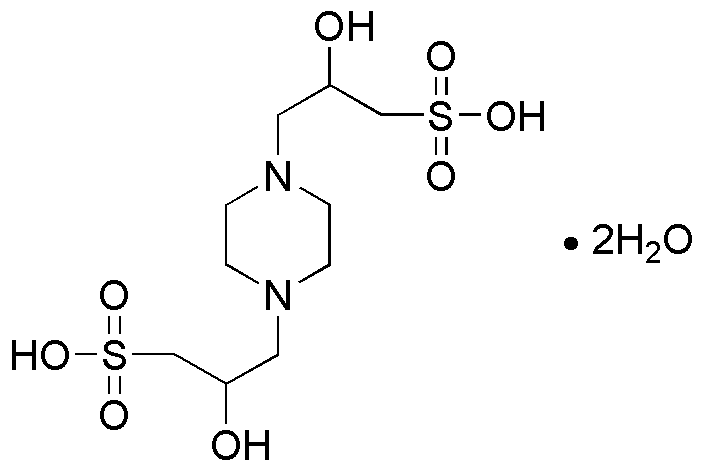Piperazine-N,N'-bis(2-hydroxypropane-sulfonic acid) dihydrate is widely utilized in research focused on:
- Biological Buffers: Commonly used in biological and biochemical research, it helps maintain pH stability in various laboratory experiments, ensuring optimal conditions for enzyme activity and cell culture.
- Pharmaceutical Formulations: Employed in drug development, it enhances the solubility and stability of active pharmaceutical ingredients, leading to more effective medications.
- Analytical Chemistry: Utilized as a buffering agent in chromatographic techniques, it aids in the separation and analysis of complex mixtures, improving the accuracy of results.
- Cosmetic Products: Incorporated into skincare formulations, it acts as a pH stabilizer, ensuring product efficacy and skin compatibility, which is crucial for consumer safety.
- Environmental Applications: Used in water treatment processes, it helps in the removal of heavy metals and pollutants, contributing to cleaner water sources and environmental sustainability.
General Information
Properties
Safety and Regulations
Applications
Piperazine-N,N'-bis(2-hydroxypropane-sulfonic acid) dihydrate is widely utilized in research focused on:
- Biological Buffers: Commonly used in biological and biochemical research, it helps maintain pH stability in various laboratory experiments, ensuring optimal conditions for enzyme activity and cell culture.
- Pharmaceutical Formulations: Employed in drug development, it enhances the solubility and stability of active pharmaceutical ingredients, leading to more effective medications.
- Analytical Chemistry: Utilized as a buffering agent in chromatographic techniques, it aids in the separation and analysis of complex mixtures, improving the accuracy of results.
- Cosmetic Products: Incorporated into skincare formulations, it acts as a pH stabilizer, ensuring product efficacy and skin compatibility, which is crucial for consumer safety.
- Environmental Applications: Used in water treatment processes, it helps in the removal of heavy metals and pollutants, contributing to cleaner water sources and environmental sustainability.
Documents
Safety Data Sheets (SDS)
The SDS provides comprehensive safety information on handling, storage, and disposal of the product.
Product Specification (PS)
The PS provides a comprehensive breakdown of the product’s properties, including chemical composition, physical state, purity, and storage requirements. It also details acceptable quality ranges and the product's intended applications.
Certificates of Analysis (COA)
Search for Certificates of Analysis (COA) by entering the products Lot Number. Lot and Batch Numbers can be found on a product’s label following the words ‘Lot’ or ‘Batch’.
*Catalog Number
*Lot Number
Certificates Of Origin (COO)
This COO confirms the country where the product was manufactured, and also details the materials and components used in it and whether it is derived from natural, synthetic, or other specific sources. This certificate may be required for customs, trade, and regulatory compliance.
*Catalog Number
*Lot Number
Safety Data Sheets (SDS)
The SDS provides comprehensive safety information on handling, storage, and disposal of the product.
DownloadProduct Specification (PS)
The PS provides a comprehensive breakdown of the product’s properties, including chemical composition, physical state, purity, and storage requirements. It also details acceptable quality ranges and the product's intended applications.
DownloadCertificates of Analysis (COA)
Search for Certificates of Analysis (COA) by entering the products Lot Number. Lot and Batch Numbers can be found on a product’s label following the words ‘Lot’ or ‘Batch’.
*Catalog Number
*Lot Number
Certificates Of Origin (COO)
This COO confirms the country where the product was manufactured, and also details the materials and components used in it and whether it is derived from natural, synthetic, or other specific sources. This certificate may be required for customs, trade, and regulatory compliance.


